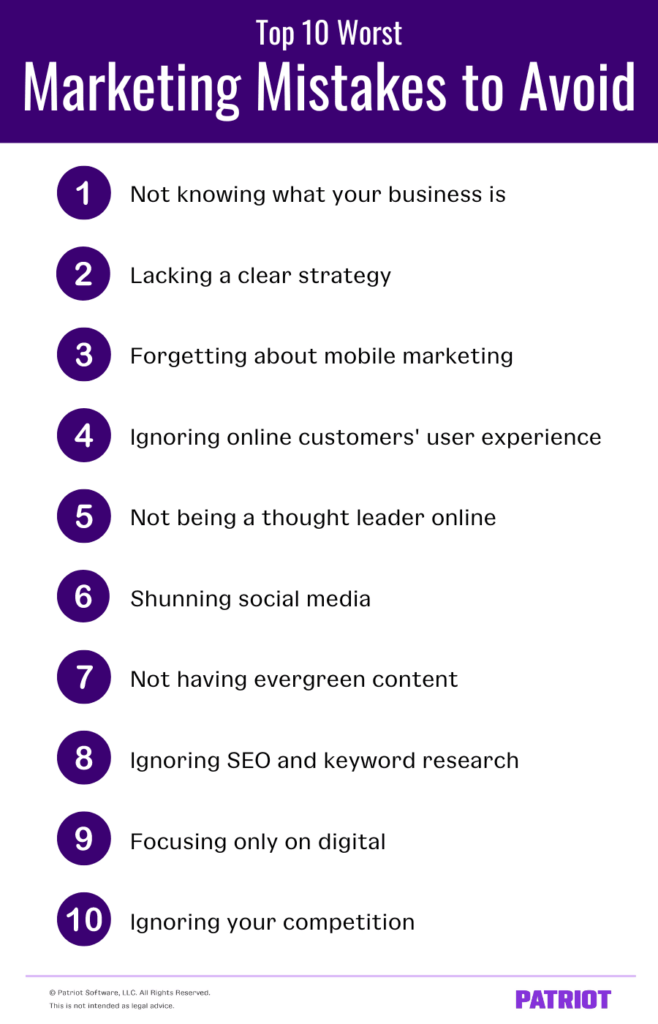One of the great things about running your own business is that there’s no one to answer to but yourself. You are your own boss. The kingpin. The top dog. The big cheese … well, you get the point. While that’s usually a blessing, it can also be a curse if you make the wrong marketing decision. To help out, we’ve put together a list of the top 10 worst marketing mistakes to avoid.
Marketing mistakes to avoid
Marketing your business can feel like trial and error. Worst-case scenario? It feels like a losing battle. But, it doesn’t have to be that way. Here are the top 10 worst marketing mistakes to avoid to help keep you on the right track.

1. Not knowing what your business is
Knowing your business may seem obvious, but you’d be surprised how many small business owners don’t give it enough thought.
Understanding what your business is can cover a lot of ground. You’ll need to consider what:
- Industry you’re in and the unique value you add to it (so, what’s your unique value proposition?)
- Customers you want to attract and turn into repeat customers
- Your story is and how to tell it
- Your brand is
The niche you carve out in your industry should appeal to your customers and have your brand and its story written all over it. If you can make your brand synonymous with the product you offer and the customers you serve, you are setting yourself up for years of success.
2. Lacking a clear strategy
Running a business can be exciting, especially when you take chances and make big wins. But, it can be easy to get distracted when thinking of new ways to connect with customers and increase sales or expand offerings. Don’t throw things against the wall just to see what sticks.
When you know what your brand is and who your customers are, don’t deviate from what works. You don’t want your customers wondering if your business is a shoe company, a ski boat rental, a hair salon, or all three (what a combo!).
If you offer too many things or start to muddy your brand, you’ll lose customers and find it hard to create repeat customers. Build trust and loyalty and be dependable (your customers will be happy you did).
3. Forgetting about mobile marketing
While it isn’t news to any small business owners, it does bear repeating: Don’t forget about customers that connect with your business on their smartphones or tablets. Americans spend at least 5.4 hours per day looking at their phones and pick them up at least 58 times a day. If your customers can’t ignore their phones, why would you?
First things first, make sure that you use responsive web design. Responsive web design allows your website to adapt to a user’s chosen mode of browsing. That way, online visitors can enjoy the same experience on a phone or tablet as they would on a computer.
Mobile marketing isn’t just about responsive web design but the whole user experience (UX) of your mobile online business. Here are four ideas to get you started on your mobile marketing campaign:
- SMS-based marketing: Getting in touch with your customers via text might not be on your radar, but it should be. It’s efficient. If you start an SMS marketing campaign, chances are your audience will listen. On average, recipients open 99% of SMS messages. For comparison, email marketing only has a 20% open rate.
- App-based marketing: Designing an app for your e-commerce business is a great way to be a touch away for your customers.
- QR codes: QR codes allow mobile users to view a website, landing page, or social media profile simply by putting the QR code in front of their cell camera.
- Location-based marketing: Location-based marketing lets you send specific ads to your customers as soon as they show up in a specific area.
4. Ignoring online customers’ user experience
In 2021, e-commerce sales in the U.S. were $870 billion. That’s a 14.2% increase from the previous year. Want to break into e-commerce sales, too? Give your online store as much attention as you would your brick-and-mortar.
Think about the customer’s user experience when they’re on your website. To help do this, ask questions like:
- Does the website effectively display your brand?
- Is the website easy to navigate and use (from the first page to checkout)?
- Are there chances for customers to leave reviews online?
5. Not being a thought leader online
This may come as a surprise, but a good business doesn’t just sell a good product or market effectively. A good business is a thought leader in its industry. There are plenty of ways to be a thought leader online. You can publish a blog, run a YouTube channel, or work hard for connections on LinkedIn.
Whatever you do, make sure that you offer valuable and accessible content to customers and competition alike.
Don’t think of content solely as blog posts. Videos and pictures are great ways to attract customer attention and get your message across, too.
6. Shunning social media
There are 302 million social network users in the U.S. That means you have 302.5 million potential customers waiting for you to find them on social networks.
But before you get started on social media, you need to decide which platforms are right for you.
If your customers are generally over 35 years old, TikTok may not be the best choice. Eighty percent of TikTok users are between 16 and 34 years of age. But on Facebook, 53.5% of users are 35 years of age or older.
7. Not having evergreen content
Building content online is great, but you want to make sure that it is evergreen. Evergreen content stands the test of time—it’s something that is relevant and sustainable, bringing users to your site time and time again.
There isn’t just one type of evergreen content. Think about including these types of evergreen content in your blog:
- “How-to” guides
- Testimonials
- Tutorials
- Frequently Asked Questions (FAQs)
- Resources
Let’s look at an example of how you could use evergreen content for your company. You run a shoe company that’s thinking about creating evergreen content. You may think about offering a how-to guide to cleaning shoes by hand and in the washer, or tutorials on creative ways to lace the shoes.
Your evergreen content works best when it has your customers in mind.
8. Ignoring SEO and keyword research
Search engine optimization is part of a company’s digital marketing and involves techniques to help your website rank higher on search engine result pages. SEO optimization helps your customers find you online.
SEO techniques include:
- Keyword research
- Optimizing title and meta descriptions
- Optimized content
Keyword research
Keywords are any terms that users type into a search engine. Keyword research means looking at how many people are searching particular terms.
Widely used keywords are known as competitive; you’ll have a hard time ranking with them on Google. A good example of a competitive keyword is “shoes.” The keyword is too general to be of any use.
You’ll have better success with long-tail keywords, which have a relatively low search volume and aren’t that competitive. Instead of “shoes,” which is too competitive, think of using a long-tail keyword particular for your business. If your company sells used basketball shoes, a long-tail keyword like “basketball shoes popular in 1980,” may be just what you need.
Optimizing title and meta descriptions
Keyword research is only half the battle. Make sure that you optimize your title and meta descriptions on your website to improve your click-through rate (CTR). CTR means that people are clicking on your search results when they find them.
Measuring your CTR is simple. Divide your total number of impressions by your total number of clicks. If your shoe company generates 1000 impressions for a new blog post, but only 50 clicks, you have a CTR of 5%. You may want to change your title and meta descriptions.
Optimized content
Now that you know about keyword research and how optimizing title and meta descriptions can help your SEO, don’t forget about old posts. Going through old posts and updating their keywords, titles, and meta descriptions will help those old pages rank in search engines. You want a holistic approach to your SEO—working hard on both new and old content.
9. Focusing only on digital
Sure, things are going digital. And yes, SEO is one of the best ways to get noticed online. But, don’t forget that your customers also spend time offline. Think about the special ways you can interact with your customers offline.
Here are some analog ideas to reach out to your customers:
- Create handwritten thank you notes or personalized snail mail
- Design unique in-store experiences
- Offer something tactile in appreciation for their business (e.g., branded tote bags or branded seasonal swag)
Take advantage of your storefront and the unique marketing opportunities it offers. Here are some questions to ask when thinking about improving your brick-and-mortar storefront:
- How can you capture the attention of people outside your store? If you have big display windows, you may want to think about creative ways to catch people’s attention.
- How can you make your in-store displays more interesting? In-store displays are as much about organizing customer movement as they are about catching their attention. If your store is too crowded with displays, your customers will notice. Use space to highlight certain products. Well-placed displays and signage can speak volumes.
- What can you offer local customers that only they would appreciate? Curate offerings to your customers that show an appreciation for the community or the region your business serves. Doing so can go a long way to converting customers into brand warriors.
10. Ignoring your competition
If you ignore your competition, there’s no chance you can stand out and make a name for yourself. Spend time researching the competition in your industry and your region. Once you know what’s out there, you can figure out how to stand out.
Whatever you do, make sure that it is true to your brand and your story. If you choose a way to stand out that seems inauthentic, your customers will smell it from a mile away.
Be true to yourself and your brand and you’ll stand out no matter what.
This is not intended as legal advice; for more information, please click here.
